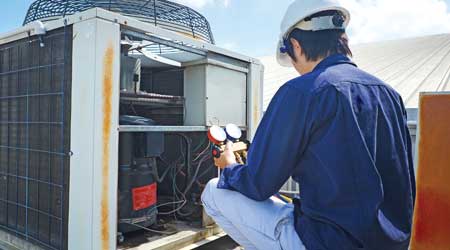 Performing routine diagnostics on building equipment can help managers determine how energy is being used within a building.
Performing routine diagnostics on building equipment can help managers determine how energy is being used within a building.HVAC: Monitoring and Reducing Energy Waste
The benefits to addressing energy waste can be considerable - happier occupants, lower equipment loads, and energy savings.
Monitoring for savings
The effort of monitoring, diagnosing, correcting, and tracking is no small task, but the benefits can be considerable — happier occupants, lower equipment loads, and energy savings. In fact, such efforts are one of the general tenets of ongoing commissioning performed by engineering or energy consulting firms.
Monitoring and diagnosis occurs in coordination with an energy measure implementation phase, where the energy engineer has identified ways to enhance the control sequences of HVAC equipment in order to run the equipment more optimally to meet building loads.
For example, instead of resetting the discharge-air temperature on AHUs based on outside air conditions, new programming could be written that monitors the cumulative zone cooling requests and resets static pressure and discharge air temperature in coordination with each other rather than independently.
This could have the benefit of saving significant energy if the ratio of the building surface area — the envelope— to its volume is relatively low and, thus, less affected by external loads. Or it could increase comfort if the ratio of building surface area to its volume ratio is relatively high and, thus, heavily affected by outdoor conditions. These types of comprehensive efforts can save 10-25 percent annually on utility expenses and pay off in under two years.
With trending already set up on all HVAC systems, the operator or energy engineer can easily identify the zones that might have the highest cooling requests and, as a result, will prevent the reset schedules from working fully. If these trouble zones have mechanical issues that prevent them from cooling properly — for example, a failed damper actuator or open hot-water valve — maintenance technicians can respond quickly to prevent excessive energy use for fans and chilled water.
Building buy-in
For maintenance technicians to be fully on board with a monitoring and diagnostics effort, they need to be included as a critical component of the team and updated on progress accordingly. In order to show progress, managers need to track both energy and occupant comfort and report results to the team regularly so they can receive recognition for their efforts when savings are positive and complaints are low.
Over the years, I have listened to maintenance technicians express this sentiment. It is a great feeling for an operator when a dollar figure can be directly linked to an operational problem the technician found and corrected. Managers need to show this benefit as something that would have otherwise had gone unnoticed had the technician not had this new diagnostic process in place.
Ongoing monitoring is relevant for all buildings. Even new construction projects with state-of-the-art control systems can benefit from the approach. I have used diagnostic tools on several new construction projects and newly renovated buildings to identify significant issues that contractors missed at the startup or during the warranty period.
Having a platform in place can help the maintenance staff identify minor issues before they become major headaches. It also can add accountability and tracking to the issues identified. This holistic strategy for assessing building health can give the operations staff confidence, as well as proof that their maintenance solutions are working and sustainable over time.
Ben Shepard, P.E., CPM, is a project manager with Smith, Seckman, Reid, Inc. — www.ssr-inc.com. He has been in the demand side management and facility energy consulting business for 10 years.
Related Topics:














